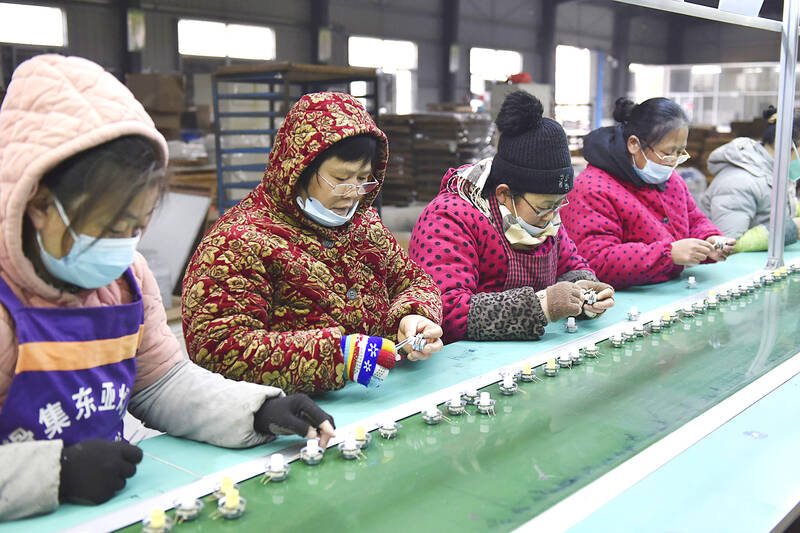China’s factory activity shrank at the sharpest pace since the COVID-19 pandemic first emerged about three years ago, after Beijing’s abrupt reversal of counter-epidemic measures last month set off a wave of COVID-19 infections across the country.
The official purchasing managers’ index (PMI) fell to 47.0 last month from 48.0 in November, the National Bureau of Statistics said on Saturday.
Economists in a Reuters poll had expected the PMI to come in at 48.0. The 50-point mark separates contraction from growth on a monthly basis.

Photo: AP
The drop was the biggest since the early days of the pandemic in February 2020.
The data offered the first official snapshot of the manufacturing sector after China removed the world’s strictest COVID-19 restrictions last month. Cumulative infections likely reached 18.6 million last month, UK-based health data firm Airfinity said.
Analysts said surging infections could cause temporary labor shortages and increased supply chain disruptions.
Weakening external demand on the back of growing global recession fears amid rising interest rates, inflation and Russia’s invasion of Ukraine could further slow China’s exports, hurting its massive manufacturing sector and hampering an economic recovery, they said.
“Most factories I know are way below where they could be this time of year for orders next year. A lot of factories I have talked to are at 50 percent, some are below 20 percent,” said Cameron Johnson, a partner at Tidal Wave Solutions, a supply chain consulting firm.
“So even though China is opening up, manufacturing is still going to slow down because the rest of the world’s economy is slowing down. Factories will have workers, but they will have no orders,” Johnson said.
The bureau said 56.3 percent of surveyed manufacturers reported that they were greatly affected by the epidemic last month, up 15.5 percentage points from the previous month, although most also said they expect the situation to gradually improve.
In 2021, inflation-adjusted GDP reached 114.92 trillion yuan (US$16.66 trillion), up 8.4 percent from 2020. GDP expanded 3 percent in the first nine months of last year, compared with China’s official full-year goal of around 5.5 percent.
The World Bank expects growth for last year of 2.7 percent.
The non-manufacturing PMI, which looks at services sector activity, fell to 41.6 from 46.7 in November, the bureau’s data showed, also marking the lowest reading since February 2020.
The official composite PMI, which combines manufacturing and services, declined to 42.6 from 47.1.
“The weeks before Chinese New Year are going to remain challenging for the service sector as people won’t want to go out and spend more than necessary for fear of catching an infection,” Capital Economics head Asia economist Mark Williams said.
“But the outlook should brighten around the time that people return from the Chinese New Year holiday — infections will have dropped back, and a large share of people will have recently had COVID and feel they have a degree of immunity,” he said.

Taiwan Semiconductor Manufacturing Co (TSMC, 台積電) last week recorded an increase in the number of shareholders to the highest in almost eight months, despite its share price falling 3.38 percent from the previous week, Taiwan Stock Exchange data released on Saturday showed. As of Friday, TSMC had 1.88 million shareholders, the most since the week of April 25 and an increase of 31,870 from the previous week, the data showed. The number of shareholders jumped despite a drop of NT$50 (US$1.59), or 3.38 percent, in TSMC’s share price from a week earlier to NT$1,430, as investors took profits from their earlier gains

In a high-security Shenzhen laboratory, Chinese scientists have built what Washington has spent years trying to prevent: a prototype of a machine capable of producing the cutting-edge semiconductor chips that power artificial intelligence (AI), smartphones and weapons central to Western military dominance, Reuters has learned. Completed early this year and undergoing testing, the prototype fills nearly an entire factory floor. It was built by a team of former engineers from Dutch semiconductor giant ASML who reverse-engineered the company’s extreme ultraviolet lithography (EUV) machines, according to two people with knowledge of the project. EUV machines sit at the heart of a technological Cold

TAIWAN VALUE CHAIN: Foxtron is to fully own Luxgen following the transaction and it plans to launch a new electric model, the Foxtron Bria, in Taiwan next year Yulon Motor Co (裕隆汽車) yesterday said that its board of directors approved the disposal of its electric vehicle (EV) unit, Luxgen Motor Co (納智捷汽車), to Foxtron Vehicle Technologies Co (鴻華先進) for NT$787.6 million (US$24.98 million). Foxtron, a half-half joint venture between Yulon affiliate Hua-Chuang Automobile Information Technical Center Co (華創車電) and Hon Hai Precision Industry Co (鴻海精密), expects to wrap up the deal in the first quarter of next year. Foxtron would fully own Luxgen following the transaction, including five car distributing companies, outlets and all employees. The deal is subject to the approval of the Fair Trade Commission, Foxtron said. “Foxtron will be

INFLATION CONSIDERATION: The BOJ governor said that it would ‘keep making appropriate decisions’ and would adjust depending on the economy and prices The Bank of Japan (BOJ) yesterday raised its benchmark interest rate to the highest in 30 years and said more increases are in the pipeline if conditions allow, in a sign of growing conviction that it can attain the stable inflation target it has pursued for more than a decade. Bank of Japan Governor Kazuo Ueda’s policy board increased the rate by 0.2 percentage points to 0.75 percent, in a unanimous decision, the bank said in a statement. The central bank cited the rising likelihood of its economic outlook being realized. The rate change was expected by all 50 economists surveyed by Bloomberg. The